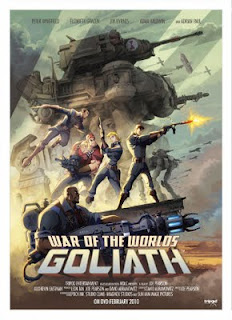
Next year will see the release of Tripod Entertainment's animated Steampunk film WAR OF THE WORLDS: GOLIATH. The film's premise is that 15 years after the Martian's failed attack on the earth in 1900 the aliens return to continue their attempted conquest of Earth. Much has changed in the intervening 15 years, as the industrious have reverse engineered a substantial amount of Martian technology. This sets the stage for a more evenly balanced conflict between the two worlds. The film's trailer hints at what the film will offer. The film will star geek favorites Adam Baldwin, Peter Wingfield, and Adrian Paul.
GOLIATH isn't the first WAR OF THE WORLDS sequel to make its way through the Hollywood entertainment assembly line. In 1988, there was a 2 season syndicated television series based on the premise that the Martians who invaded during the George Pal film merely went into hibernation and didn't die when they collapsed. The series aired in the US on Fox, and it too starred Adrian Paul (during the 2nd season).
The narrative premise of GOLIATH is a promising one and the show looks to have combined the best of the Steampunk genre with some elements of the classic animated television series STAR BLAZERS. Instead of a giant space faring WWII battleship, we have a giant sky spanning battle-zeppelin. I think the battle-zeppelin wins hands down.
Steampunk is a genre that has been gaining some momentum over the past few years. It combines "Vernian" futuristic technology with a Victorian/Edwardian time frame. I would posit that the first iteration of Steampunk was the Castle Falkenstein roleplaying game by Mike Pondsmith of R. Talsorian Games (publishers of the Cyberpunk rpg) and that the genre gained real traction with the novels The Difference Engine by Gibson and Sterling and The Prestige by Priest.
It has been noted in the comments that I am in error with regards to the origin of the term and genre of Steampunk. I will concede the term's origin, but I would take issue with some of those items retroactively classified into the genre. One could classify Spenser's The Faerie Queene as Epic Fantasy, but one would be misapplying a term for fantasy fiction in the post-Morris era. The same holds for Wild, Wild, West which shares as much with James Bond as it does with Steampunk (specifically). One might as well classify Ian Fleming's brilliant Chitty Chitty Bang Bang as Steampunk. Wikipedia and "internet citations" from Locus be damned!

1 comment:
No.
Wikipedia, of all things, gives a more straightforward history of steampunk:
Several works of fiction significant to the development of the genre were produced before the genre had a name. Titus Alone by Mervyn Peake, published in 1959, anticipated many of the tropes of steampunk.[3] Quite possibly one of the earliest mainstream manifestations to invoke the steampunk ethos was the original The Wild Wild West television series that ran on CBS from September 17, 1965 to April 4, 1969, while the 1999 film remake of the series was one of the first contemporary steampunk motion pictures.[2]
Keith Laumer made an early contribution to the genre with his Imperium series of which the first installment, Worlds of the Imperium, was published in 1962. Ronald W. Clark's 1967 novel Queen Victoria's Bomb has been cited as another early influence upon the genre,[4] as has Michael Moorcock's 1971 Warlord of the Air [5] (the first volume of Moorcock's steampunk trilogy A Nomad of the Time Streams, continued in 1974 and completed in 1981). Harry Harrison's 1973 novel A Transatlantic Tunnel, Hurrah! portrays a British Empire of an alternate 1973 A.D., full of atomic locomotives, coal-powered flying boats, ornate submarines and Victorian dialogue.
Because he coined the term, K.W. Jeter's 1979 novel Morlock Night is typically considered to have established the genre.[6]
Post a Comment